will know about. Simon Jones travels to Italy to find out more about the six generation family company
Nestled within the quiet town of Castiglione Olona is one of the true giants of the eyewear business – a company that was founded in 1849 and has survived two world wars and turbulent economic times. But the company, which has spanned six generations of the Mazzucchelli family, remains something of an unsung hero in optics. How often has a frame sales rep come into a practice with a case of frames and mentioned ‘Mazzucchelli acetate’, but glossed over what that actually means? Mazzucchelli has an abundance of pedigree, but prefers to quietly go about its business.
The company’s early days were humble, with a small factory manufacturing combs and buttons made from animal horn, bone and tortoiseshell. It was founded by Santino Mazzucchelli, who eventually passed the company on to his two sons Angelo and Pompeo.
In 1906, the company established a factory in Castiglione Olona, an area north of Milan where the river Olona supplied factories with materials.
As the years went on, the company’s technical ability and reputation in celluloid production increased. In 1927, the company signed an agreement with Du Pont for the production of celluloid, and began to work on the production of cellulose acetate sheets, which would eventually replace cellulose nitrate across many industries due to nitrate’s flammable properties.
After World War II, the company started to manufacture other products alongside celluloid. This included nitrocellulose for varnish and transparent packaging in the pharmaceutical sector. By the late 1960s, it had diversified into the worlds of art, fashion, industrial design and the sports sector – producing skis for the Italian national skiing team.
The mid-1970s saw the acquisition of sunglass and ophthalmic lens producer, Sola, and a gradual shift of focus towards the eyewear sector. Optical acquisitions over the years have included hinge-maker Comotec and GUMA, producer of optical sheets for the sport and safety sectors.
Production facilities in Castiglione Olona and Venegono Superiore is where all of the Mazzucchelli 1849 range of products is manufactured. Castiglione Olona also houses product development and research laboratories. A further two production plants in China, located in Shenzhen and Shanghai, make cellulose acetate sheets mainly made for the Asian market, to satisfy local demand.
In New York and Hong Kong, two showrooms grant support to frame brand customers by displaying the entire range of products and act as windows to monitor local market fashion trends.
Production
The cellulose acetate produced by Mazzucchelli is not plastic in the traditional sense, its main ingredient is cellulose powder, which is an extract of cotton. Flakes of cotton are pushed and squeezed through a large press to create a transparent paste that is used as a base for the large sheets made further down the production line.

The ingredients needed to produce acetate
Parts of the paste sections are cut off and put through heated rollers until it reaches the desired thickness. Coloured powders are carefully added and mixed with acetone and spread over the raw transparent acetate.
The crudely coloured paste is then pressed again, until the colour is the same all over. Samples of the paste are taken throughout the process so that they can be checked for future reference and production.
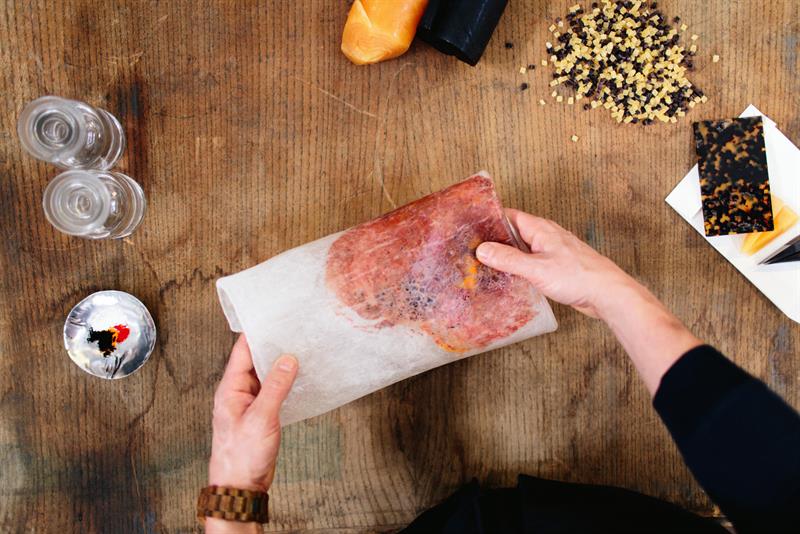
Coloured powders are added to the raw acetate and rolled until colour is uniform
At this stage the acetate is still unrecognisable from the sheet form that one typically imagines. The coloured paste is rolled and cut into tiny cubes and if there is more than one colour to add, a tortoiseshell for instance, this is added at this stage. The granules of coloured acetate are mixed together and once again subjected to another rolling process. Here a completely new piece of acetate is created, with different colours and textures. The piece is placed in a press for around one day and the block is carefully sliced into large sheets, which go on to be cut into smaller pieces when they arrive at their frame production stage. Before this can happen, the acetate needs to cure, getting rid of any excess solvents. The acetate created in this fashion is described as extrusion acetate. Lamination acetate is made in a similar fashion as extrusion, but the sheets are placed on top of one another at the pressing stage and slowly bonded together.
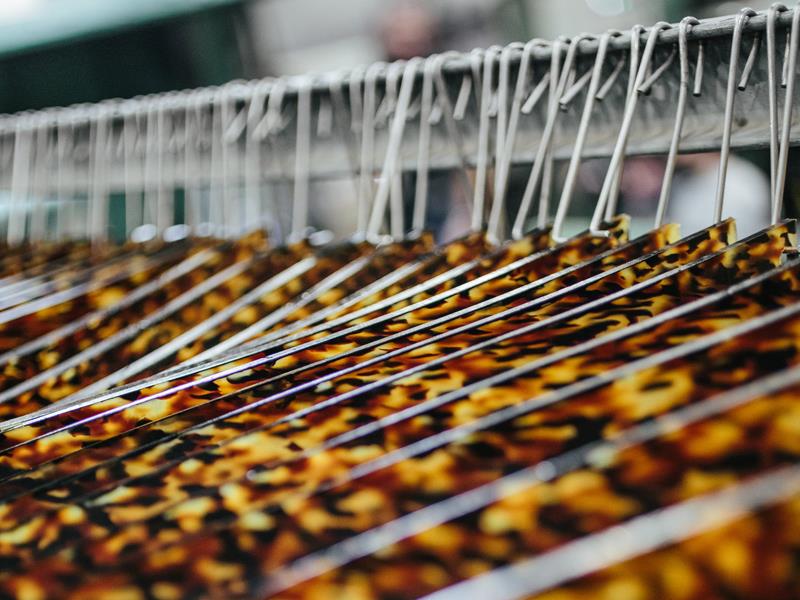
Acetate sheets curing
Mazzucchelli manufactures a wide range of acetate colours, but it is the block process that represents the greatest attraction for stylists and designers, because the block, being made up of many different elements, can create inimitable effects and maximum creativity. Block acetate, which is considerably more expensive to purchase, can be recognised by the direction of the patterns. If the patterns within the acetate move in different directions, then the frame uses acetate made using the block technique. Extrusion acetate can be identified by patterns which move in one direction across the frame.
Claudio Crespi, area manager, responsible for the company’s sales in the UK market, says block acetate use is increasing, with more brands and designers looking to stand out from the crowd, and a colour scheme that cannot be fully recreated helps them do that. ‘It’s our expertise in this type of acetate production that we are known and respected for,’ he adds.
Repeatability is another major strength of the company. The details of each master batch will be recorded so that further batches have the same finished colour. Having records of each batch also helps when the company is producing colours for frame brands. Exclusive use of colours is something that frame brands will often mention when talking about their products. Once the client has selected a product, a two-year exclusivity period will be granted by the company. Should the frame producer order more acetate, the company will often extend this exclusivity period, but if no re-orders are made, the colour option will be open to others after consultation with the original rights holder. In the event of a frame brand coming to Mazzucchelli with an idea for a colour or pattern that is too close to an existing rights holder, the company will politely explain that this option is not currently available.

A sample of the 25,000 acetate chips in the archive
The workforce
Innovation and pushing for new quality levels are nothing without a good workforce. The company has 1,100 employees worldwide, and says it has a strong commitment to them. ‘We generally don’t speak about figures, but quality,’ says Elena Orsi Mazzucchelli, product development manager. ‘Quality of relationships, quality of life and quality of people. Each Mazzucchelli employee feels part of a large family; internal relationships are pleasant and all this leads, thanks to the quality of people, highly specialised and trained inside the company, to the creation of special products.
‘Staff turnover is close to zero. I belong to the sixth generation of my family, but it is not uncommon to find employees who represent the third or the fourth generation of their families in Mazzucchelli. Fifty years ago, the company also set up a fully paid for health centre, in which specialists in a range of disciplines are available to visit employees, their families and retirees, on a weekly basis.’
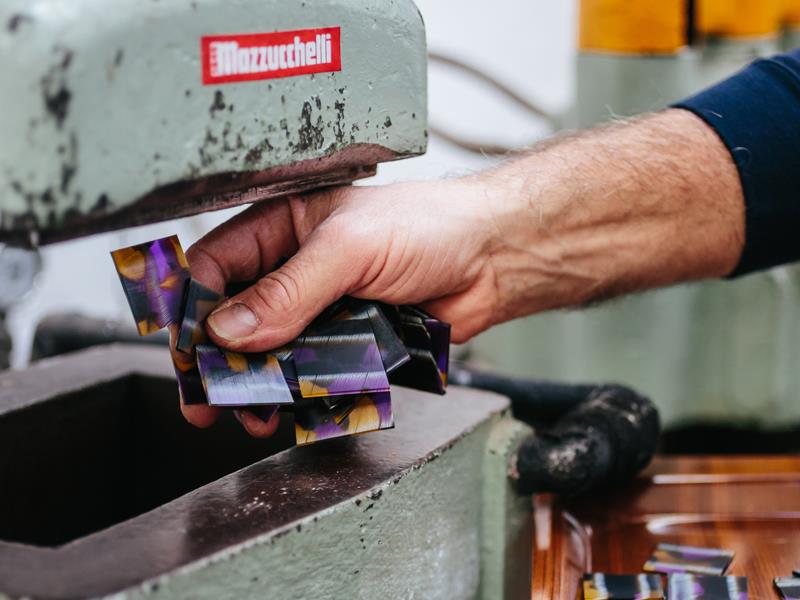
Small acetate chips are pressed together to form block acetate
Social responsibility has also featured in the company’s past. During WWII when the Italian government no longer had funds and all able bodied men were called upon by the military, the company founded a college where locals could train and gather experience of manufacturing, in preparation for peace time production.
Reputation
The acetate sheet production sector is not particularly large, but a company such as Mazzucchelli is not short of competitors. Differentiating itself from others, particularly from the Far East, is difficult, so how does the company go about doing it? ‘We like to differentiate in terms of quality and innovation, from both aesthetic and technical perspectives’, says Orsi Mazzucchelli.
‘The aesthetic quality is achieved thanks to the Centro O product development teams and the prototype laboratories. The technical qualities are achieved by our R&D department. These two departments are composed of 50 people, which represents 10% of our employees in Italy. We also have a constant control of the raw materials used in order to guarantee the highest quality of the products.’
Evolution
When a company has been in business for more than 160 years, it will have experienced many changes, not least in manufacturing. Orsi Mazzucchelli explains how the company has pushed its sector forward over the years. ‘Mazzucchelli has always been a great innovator and listener to the demands of the market. Due to our tradition of modernity, we are able to anticipate new needs. Some of the latest product innovations include Art Print, the best high definition acetate printing on the market and three new product and manufacturing patent applications. And of course, M49 bio plastic acetate.’
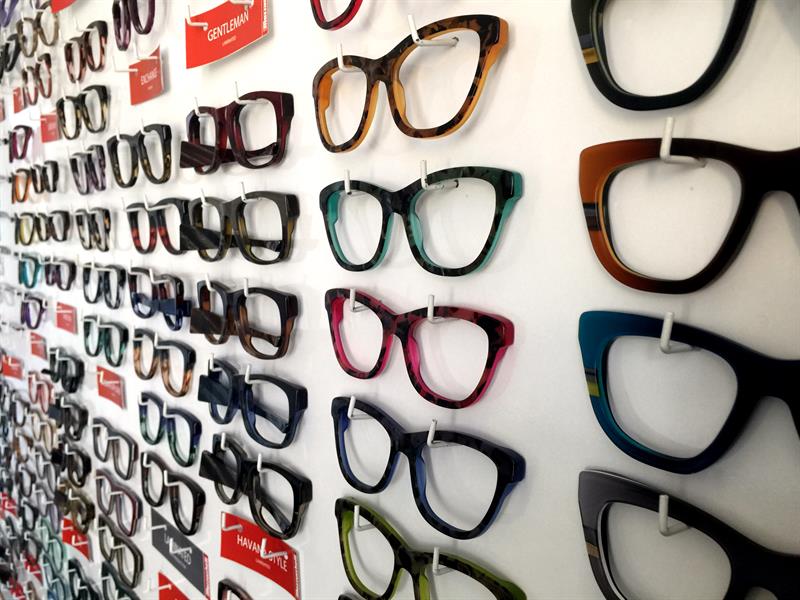
The M49 acetate is certified 100% biodegradable and friendlier to the environment. Cellulose acetate is already a mainly naturally-derived product, but the inclusion of certain plasticisers and pigments means it could be improved. In keeping with global retail trends, there is increasing demand for environmentally friendly products. By removing these plasticisers and replacing them with organic substitutes, the material conforms with ISO 14855. The first eyewear brand to use the new acetate was Gucci, but others have since followed. In fact, furniture producers have used the bio polymer to produce a new line of plastic panels for furnishing.
Relationships
To many, producing acetate sheets for the vast majority of the world’s eyewear companies would seem like a perfect scenario. However, client relationships have to be managed delicately. Mazzucchelli is organised into different areas of market requirements and specific needs. Ten members of staff, who Orsi Mazzucchelli says have deep knowledge of the market, work in the product development department to handle different markets and specific needs.
These needs will often relate to the size of the company; large multinationals will have different requirements to small brands producing limited runs. The company says it has flexible minimum order quantities, which allows it to be more flexible in terms of production differentiation – something smaller brands are constantly striving for. Lead times are also being reduced, which has tangible benefits when planning colours and textures for new collections in advance.
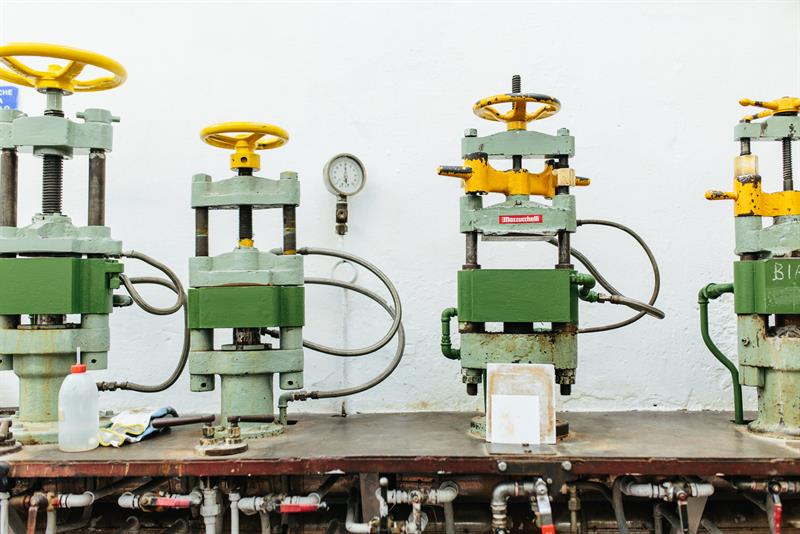
The presses
Earlier this month the company updated its website. On the face of it, a new corporate website might not sound important, but the inclusion of a tool that allows users to compare acetate colour chips from the company’s vast archive makes the process of choosing colours simpler and faster.
Crespi explains the process of working with frame brands: ‘Designers come to us and tell us what look they are trying to achieve and it’s up to us to try to achieve that for them. They could be looking for a pearl effect or a geometric design, and with an archive of around 25,000 colours and combinations from roughly the past 30 years, they should be able get close. Sometimes, looks are not always achievable, but we will always do our best.’
Modernisation is something that has happened throughout the company, but the machinery used to produce the acetate sheets remains a throwback to days gone by. With technology such as 3D printing gathering momentum in optics, is the company worried about the future?
‘Innovation has always been part of Mazzucchelli’s DNA,’ says Orsi Mazzucchelli. ‘This allows us to be a market leader and to promptly react to all the market changes. As Lewis Carrol wrote: “Now, here, you see, it takes all the running you can do, to keep in the same place. If you want to get somewhere else, you must run at least twice as fast as that!”’
